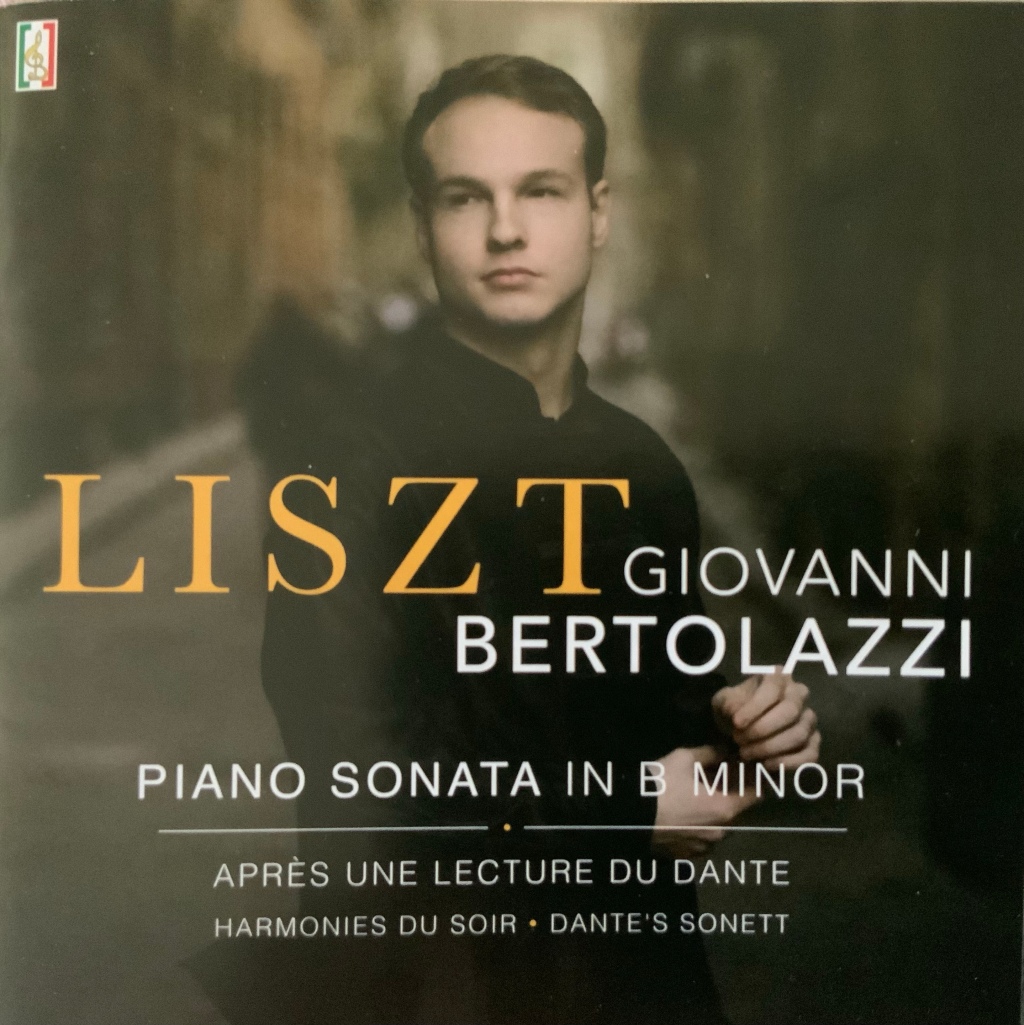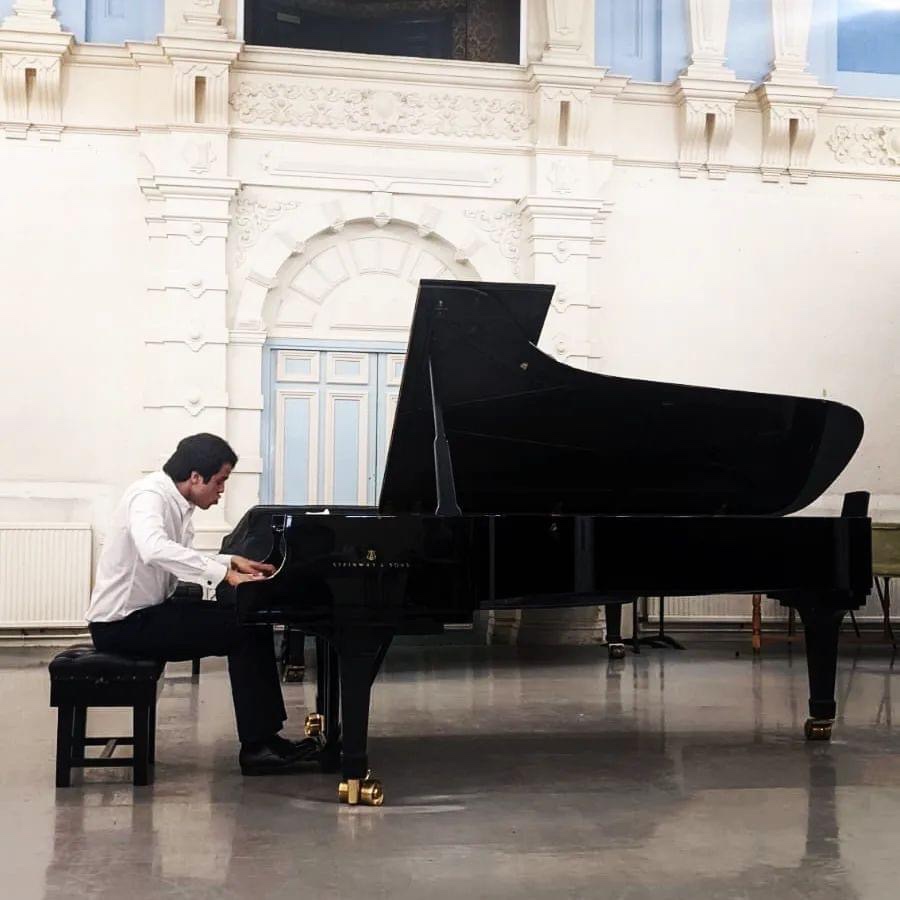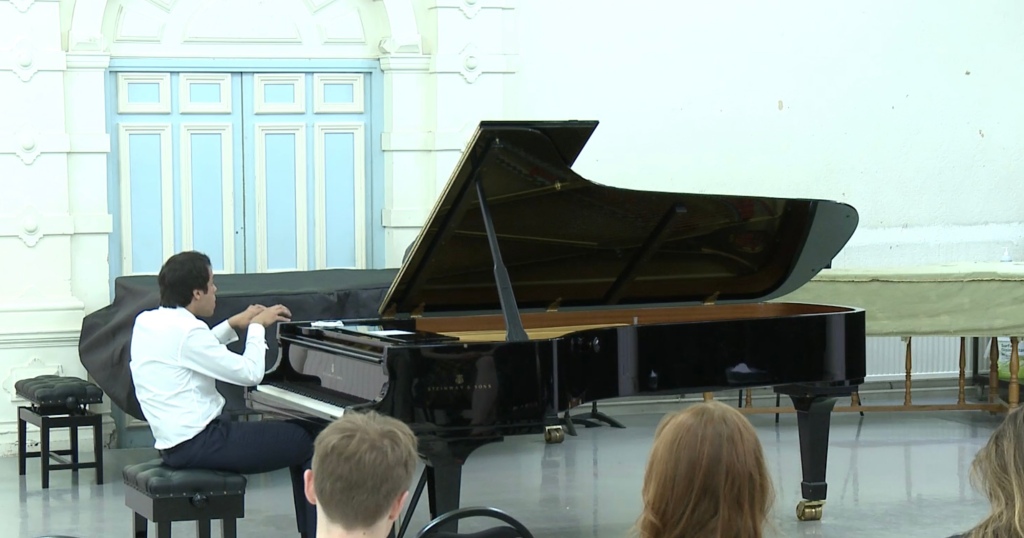
Brazil 200 celebrations with Pablo Rossi in London.
A star is truly born with playing of supreme artistry and authority with the same charm and style of Rubinstein for whom Villa Lobos wrote many of his works .Joan Chisell remarked in a review in the 70’s:’Mr Rubinstein turned baubles into gems.’
Pablo did more than that today as he convinced us of the wondrous colours and aristocratic simplicity of Villa Lobos’s two Children’s Suites.
The performance of Schubert’s Wanderer Fantasy that followed was breathtaking in its overwhelming sweep .It kept us on the edge of our seats seduced and ravished like a relentless tornado as it took us all by storm.

With the same musicianship from his years of study with Elisso Virsaladze he restored this work to the pinnacle where it belongs.Beethovenian in scope but unmistakably Schubertian in content the contrast he brought to the complex character of this early work must have been the same spark that had so inspired Liszt.
Winner some years ago of the first Nelson Freire competition he will give a concert to celebrate this much loved pianist in the hallowed surroundings at the piano festival in France at La Roque d’Antheron on the 7th August.
https://christopheraxworthymusiccommentary.com/2021/11/02/nelson-freire-rip/

What better tribute could there be from a pianist who has inherited the mantle from a true master and become he too an advocate of the music of his native Brazil.A mantle that had been inherited from Artur Rubinstein who strangely enough Pablo has always physically resembled .

https://christopheraxworthymusiccommentary.com/2019/09/21/pablo-rossi-takes-london-by-storm/
Now this young man in his early thirties who was brought to prominence at only sixteen by Noretta and John Leech of the Keyboard Trust has come of age and has inherited his rightful place as heir to this great tradition.
Ready to conquer the hearts and admiration of a world that awaits the rarity of a great artist able to move and entertain an adoring public following in the footsteps of the greatest of them all : Franz Liszt

I have written many times about Pablo’s concerts over the years,we even met a few years ago in Fiesole visiting Elisso Virsaladze where Pablo had arranged a surprise visit of her daughter from Los Angeles and tickets for a recital by Mikhail Pletnev at the Pergola Theatre in Florence https://christopheraxworthymusiccommentary.com/2020/02/16/the-return-of-a-legend-pletnev-in-florence/

Food for thought indeed from Pletnev,this elusive pianist,and the discussions between Elisso’s class after the concert were fascinating as they were bewildering.Thanks to the extraordinary humanity and unique musicianship of Elisso all was quite clear once back in her studio in Fiesole where intensive study and hard work left no room for doubt or discussion.Music is the star and the wishes of the composer are paramount …..https://christopheraxworthymusiccommentary.com/2022/07/25/mikhail-pletnev-in-verbier-fakefool-or-genius/

After his initial debut in London at the age of sixteen for the Keyboard Trust and a few months later at the Ghione Theatre in Rome Pablo went to Moscow on the advice of Noretta Conci to study with Elisso Virsaladze.A very close and trusting relationship was born over many years of intensive study as he added to his already extraordinary natural talent the unique guidance and training of a pianist much admired by Sviatoslav Richter.Graduating from the Moscow Conservatory with the highest accolades he proceeded to perfect his understanding and musical training at the Mannes School of Music with Jerome Rose in New York receiving his second masters degree in 2021

Now in 2022 the transformation from an extraordinarily talented young pianist into an artist of great stature took me completely by surprise.The assurance and authority not only in the music of his compatriot Villa Lobos and Prado ,but also the maturity and breathtaking sweep of his Schubert left me and all those present amazed.Still the young man of aristocratic bearing and irresistible charm ,even the same rather eccentric footwear,but there was above all the music and sense of communication that are of a born few.Pablo had the same charming asides that Rubinstein used to regale us with on his annual visits to London after a sumptuous feast of music played with an ease and simplicity that inspired generations of pianists.

Having finished the concert and receiving an ovation from a public overwhelmed by the audacity and beauty of his Schubert ….he thanked his friends at the Brazilian Embassy for inviting him to London but what more did they want ….his contract he had completed ?!………..

After much insistence …….Chopin was heard to be requested from the audience and it was Chopin that we got.But what Chopin! The most famous of all nocturnes op 9 n.2 in E flat played with such subtle colouring and the rubato of a great bel canto singer.Sublime simplicity. Thanks should go to the Brazilian Embassy too for inspiring a new series of recordings on the Naxos label for their 200th anniversary celebrations.Pablo has just completed the piano works of Villa Lobos and is obviously a wonderful cultural ambassador for bringing unknown Brazilian music to the fore.

Heitor Villa-Lobos March 5, 1887 – November 17, 1959 was a Brazilian composer,conductor, cellist, and classical guitarist described as “the single most significant creative figure in 20th-century Brazilian art music” and has become the best-known South American composer of all time.A prolific composer, he wrote numerous orchestral,chamber,instrumental and vocal works, totaling over 2000 works by his death in 1959.In about 1918 Villa-Lobos abandoned the use of opus numbers for his compositions as a constraint to his pioneering spirit.
With the piano suite Carnaval das crianças (Children’s carnival) of 1919–20, Villa-Lobos liberated his style altogether from European Romanticism:the suite, in eight movements with the finale written for piano duet, depicts eight characters or scenes from Rio’s Lenten Carnival.In February 1922, a festival of modern art took place in Sao Paolo and Villa-Lobos contributed performances of his own works. The press were unsympathetic and the audience were not appreciative; their mockery was encouraged by Villa-Lobos’s being forced by a foot infection to wear one carpet slipper.(sic!)

Born March 5, 1887
Died November 17, 1959 (aged 72)
In July 1922, Rubinstein gave the first performance of the piano suite A Prole do Bebê (The Baby’s Family), composed in 1918. There had recently been an attempted military coup on Copacabana Beach,and places of entertainment had been closed for days; the public possibly wanted something less intellectually demanding, and the piece was booed. Villa-Lobos was philosophical about it, and Rubinstein later reminisced that the composer said, “I am still too good for them.” The piece has been called “the first enduring work of Brazilian modernism”.Rubinstein suggested that Villa-Lobos tour abroad, and in 1923 he set out for Paris.His avowed aim was to exhibit his exotic sound world rather than to study. Just before he left he completed his Nonet (for ten players and chorus) which was first performed after his arrival in the French capital in Rubinstein’s hotel room to a select public.He stayed in Paris in 1923–24 and 1927–30, and there he met influential residents where his Parisian concerts of his music made a strong impression.

His meeting with Artur Rubinstein in 1918 prompted Villa-Lobos to compose piano music such as Simples coletânea of 1919—which was possibly influenced by Rubinstein’s playing of Ravel and Scriabin on his South American tours—and Bailado infernal of 1920.The latter piece includes the tempi and expression markings “vertiginoso e frenético”, “infernal” and “mais vivo ainda” (faster still).When touring Europe with his music he said, “I don’t use folklore, I am the folklore” and “I have not come to learn, I have come to show what I have done” showing that he was quite aware of his unique position among classical composers, and he made good use of his origins to publicise his own works.

Carnaval das crianças of 1919–20 saw Villa-Lobos’s mature style emerge; unconstrained by the use of traditional formulae or any requirement for dramatic tension, the piece at times imitates a mouth organ, children’s dances, a harlequinade , and ends with an impression of the carnival parade. This work was orchestrated in 1929 with new linking passages and a new title, Momoprecoce.
Naïveté and innocence is also heard in the piano suites A Prole do Bebê (The Baby’s Family) of 1918–21.It was exactly this naiveté and innocence that Pablo captured so beguilingly.The childlike simplicity of the melodic line chiselled out so clearly wherever it was to appear but accompanied by magic sounds that seemed to float around the melodic line with streams of gold and silver of subtle colouring.A remarkable sense of balance due to his continual gentle movements allowing him to stroke the keys with such ease that opened a Pandora’s box of kaleidoscopic sounds that sparkled and shone like jewels of voluptuous beauty.

The extended Rudepoema for piano which we had heard in a previous concert in the Brazil 200 series,played by another KCT pianist Sasha Grynyuk.It was written for Rubinstein 1921-26 and is a multi-layered work, often requiring notation on several staves, and is both experimental and demanding and the most impressive result of this formal development.It was written in Rio de Janeiro from 1921 to 1926 and is the largest and most challenging work Villa-Lobos wrote for solo piano. It is in one continuous movement and runs about 19–20 minutes.

The piece has been described as “Le Sacre du printemps meets the Brazilian jungle”.However, the score’s dedicatee, Artur Rubinstein explained, “The ‘Rude’ of the title did not have the English meaning. In Brazil it meant ‘savage’. When I asked him if he considered me a savage pianist, he said excitedly, ‘We are both savage! We don’t care much for pedantic detail. I compose and you play, off the heart, making the music live, and this is what I hope I expressed in this work'”.It was intended as a tonal portrait of Rubinstein, who premiered the work at the Salle Gaveau in Paris on 24 October 1927, on the first of a pair of concerts devoted to Villa-Lobos’s compositions.The dedication of the score to Rubinstein reads, “My true friend, I do not know if I can have fully assimilated your soul with this Rudepoema but I swear with all my heart that I have the impression in my mind of having recorded your temperament and of having mechanically transcribed it on paper, like an intimate Kodak.Therefore, if I have succeeded, you will be the true author of this work”.

José Antônio Rezende de Almeida Prado or Almeida Prado (February 8, 1943 – November 21, 2010) was an important Brazilian composer and pianist.On his death, his personal friend, conductor Joao Carlos Martins stated that Prado had possibly been the most important Brazilian composer ever.He wrote over 400 compositions and won various prizes for his work.He was born in Santos,Sao Paolo in 1943 and died there in 2010.He studied piano with Dinora de Carvalho,harmony with Osvaldo Lacerda and composition with Camargo Guarnieri and later from 1970 to 73 with Olivier Messiaen and Nadia Boulanger in Paris and brief studies with Gyorgy Ligeti and Lukas Foss in Darmstadt.

The work that Pablo played was from his suite written in 1973 ‘Ilhas’ Islands .The ‘Ice Island’ was full of mysterious sounds and vibrations spread over the entire keyboard in an impressionistic piece that owed much to Bartok in it’s insistent repeated motives creating a hypnotic atmosphere similar to that in the suite ‘Out of doors’.Here Pablo’s sense of colour and ability to create an overall form from such extraordinary sounds showed a musicianship that could form a coherent whole from such sparse shapes and colours spread over the entire keyboard.
Not expecting or getting applause he plunged straight into the ‘Children’s Carnaval’ suite by Villa Lobos.I recognised it because the first piece ‘Ginete da Pierrazinho’ had been an encore that Nelson Freire had played for us in Rome and had touchingly remembered in a later recital that it had been my late wife’s favourite piece!Nelson was an extraordinary human being and inherited the same warmth,generosity and artistry from Artur Rubinstein.

The Fantasie in C major, Op. 15 ( D.760), popularly known as the Wanderer Fantasy, is a four-movement fantasy for solo piano composed by Schubert in 1822 when only 25 in a life that was tragically cut short by the age of 31.It is widely considered his most technically demanding composition for the piano and Schubert himself said “the devil may play it,” in reference to his own inability to do so properly.The whole work is based on one single basic motif from which all themes are developed. This motif is distilled from the theme of the second movement, which is a sequence of variations on a melody taken from the lied “Der Wanderer”, which Schubert wrote in 1816. It is from this that the work’s popular name is derived.

The four movements are played without a break. After the first movement Allegro con fuoco ma non troppo in C major and the second movement Adagio (which begins in C-sharp minor and ends in E major), follow a scherzo presto in A-flat major and the technically transcendental finale, which starts in fugato returning to the key of C major and becomes more and more virtuosic as it moves toward its thunderous conclusion.Liszt was fascinated by the Wanderer Fantasy, transcribing it for piano and orchestra (S.366) and two pianos (S.653). He additionally edited the original score and added some various interpretations in ossia and made a complete rearrangement of the final movement (S.565a).

I remember a recent lesson I had listened to of Elisso Virsaladze in which I was struck by the vehemence of the Wanderer Fantasy and the ragged corners that we are more used to in a Beethoven almost twice Schubert’s age .It made me wonder about the maturity of the 25 year old Schubert and could he have had a premonition that his life was to be curtailed only six years later.We are used to the mellifluous Schubert of rounded corners and seemless streams of melodic invention.But surely in the final three sonatas written in the last months of his life the A major and C minor start with a call to arms and only in the last B flat sonata do we arrive at the peace and tranquility that Beethoven was to find too in his last sonata.But the deep rumblings in the bass in Schubert’s last sonata give food for thought that his life was not all sweetness and light.I remember Richter’s long tribulation in the recording studio to put on record as near definitive version as possible of the Wanderer Fantasy with the help of the pianist and musicologist Paul Badura Skoda.

It was exactly like a tornado with which Pablo presented the opening flourishes of this remarkable work .It was played with the authority and breathless urgency that Richter and now Trifonov had unleashed on an unsuspecting public.This was a full symphony orchestra not a chamber orchestra but one that was capable of moments of excitement and urgency but also moments of lyricism and delicacy.The contrasts that Pablo found kept us on the edge of our seats as the underlying rhythmic current flowed from the source to the mouth of this great stream of sounds.Not a Schubert for the weak hearted but a Schubert of a man that had known great tenderness but also great suffering.There was a technical prowess that seemed to have no limitations as his body movements followed the great streams of sound that poured out of this little Boston with then same dynamic energy and richness as the greatest of concert grands.

The natural movements that followed the contours of the music allowed him to seek out sounds without any ungrateful hardness even in the most challenging passages that abound in a work that the composer himself said : ‘May the devil play it ‘.The fullness of rich sound in the solemn Adagio – The Wanderer – was remarkable for its sonority.I even found it a little too important a statement but was then led by Pablo to the magic of the variations where streams of golden sounds just poured like water over the keys leading to a climax worthy of the mightiest of Beethoven only to disappear in a series of vibrations all so similarly found in late Beethoven.The scherzo ,presto,was played with a clarity and sense of dance that created just the contrast and lyrical interlude before the tumultuous final explosion in preparation for the Allegro fugato.

Noretta and I looked at each other as he embarked on the Allegro with an urgency almost in two instead of four.But we need not have worried as Pablo is also a great virtuoso as he fearlessly led us to the tumultuous conclusion with no sign of collision or mishap.A remarkably exciting conclusion to a superb performance.

















































































